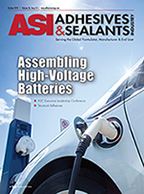Moving On
The adhesives and sealants industry is vibrant and dynamic, supporting myriad vital end-use sectors, and I’ll miss sharing the latest advancements and technologies with you all.

Before sharing some of this issue’s highlights with you, I’d like to relate a bit of personal news. After more than two decades with BNP Media, ASI’s parent company, I’ve decided to step away in order to pursue new opportunities. Though I’m excited about what’s to come for me, this is a bittersweet moment.
I’ve enjoyed working with so many of you over the years! The adhesives and sealants industry is vibrant and dynamic, supporting myriad vital end-use sectors, and I’ll miss sharing the latest advancements and technologies with you all.
I’m thrilled to share that Karen Parker will be the new editor of ASI. Karen has been an invaluable help with our news coverage and eNewsletters over the past year or so, and she’s handled a number of editorial duties for Paint & Coatings Industry for nearly 15 years.
Please don’t hesitate to reach out to Karen at parkerk@bnpmedia.com with any content-related questions or suggestions you may have. Though I’m sentimental about my departure, I’m excited to see what Karen will bring to ASI and the industry.
But enough about me! We’ve got lots of great content lined up for you in this issue, including the 2022 Carl Dahlquist Award-winning paper. Lead author Joseph D. Binder, Ph.D., of Dow presented “Designed Polymer Particle Architectures for Waterborne Acrylic Pressure-Sensitive Adhesives” at the Pressure Sensitive Tape Council’s 2022 Tape Week this past May.
“In this work, an alternative particle architecture was investigated for enhanced PSA properties,” Binder and the team write in the paper. “A pre-strained interpenetrating network was designed into each particle through a multistage polymerization process… The PSA properties and polymer rheology of films made from these designed polymer particles were investigated to identify opportunities to improve the adhesion/cohesion balance of waterborne PSAs.”
“Part 1: Introduction and Experimental” appears in this issue of ASI. The conclusion, “Part 2: Results and Discussion,” will be featured in next month’s edition.
Be sure to dig in to the annual “Raw Materials and Chemicals Overview” feature in this issue as well. Authored by Michael Rezai of The ChemQuest Group, this always-popular piece provides historical and present-day context on key materials and chemicals-related issues influencing the industry, as well as outlooks for the future.
We’re also highlighting transportation-related end-use applications in this issue. For example, form-in-place gaskets (FIPGs) are evolving to meet the changing needs of the automotive industry. ThreeBond International’s Thomas Jones shares details in “Process and Design Decisions for Successful Form-in-Place Gasket Sealing.”
Looking for a reprint of this article?
From high-res PDFs to custom plaques, order your copy today!






